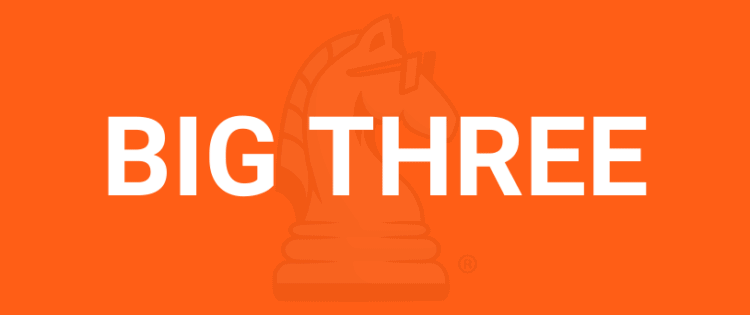
OBJECTIVE OF BIG THREE: The objective of Big Three is for your team to score either 91 or 121 points first.
NUMBER OF PLAYERS: 3 Players
MATERIALS: A 52-card deck, chips or other betting tokens, and a flat surface.
TYPE OF GAME: Shedding Card Game
AUDIENCE: Adult
OVERVIEW OF BIG THREE
Big Three is played by three players. The rounds are played 2 against 1 and bets are made for who can empty their hand first. Players will have an action to determine who will be playing alone and then the side that empties their hand first will win the bids made during the auction.
The gameplay is a mix of tricks and shedding, where players want to empty their hands as quickly as possible but must beat previously made tricks to play cards out.
SETUP
A random player will be the dealer first. After this round, the winner of the previous round will deal next. The dealer will shuffle the deck and the player to their left will cut. The deck is then placed in the center of the table and draws the top card for themselves. The player to their right will do the same and this will continue in counterclockwise order until all players have a hand of 16 cards. The remaining 4 cards will be left in the center until after the action.
Card Rankings
In Big Three the card suits do not matter but the ranking does. All suits are ranked the same and, in this game, there are no trumps for tricks. The ranking is 3 (high), 2, Ace, King, Queen, Jack, 10, 9, 8, 7, 6, 5, and 4 (low).
AUCTION
There is an auction held after all players receive their hands. Players will compete to see which of them will be the player on their own. The player with the 4 of hearts, or the lowest ranking heart, will start the bid. The bid options are 1 unit, 2 units, or three units. The player starting the option must bid 1 unit at least. Then in counterclockwise order players will either increase the bid or pass. The auction is complete when 2 players have passed or a bid of three has been made by a player. The winner of the auction will then pick up the 4 remaining cards from the center of the table for their hand.
GAMEPLAY
The player who began the auction will start the game as well. They will play one of the valid sequences of card(s) to start and then in counterclockwise order following players can either pass or play a higher-ranking sequence of the same type. This continues around the table until two consecutive players pass. Then the previously played cards are turned face down and the player who played the highest-ranked card(s) of the last trick will lead the next one. This continues until a player runs out of cards in hand.
The valid types of card(s) are as follows. Players may play a single card. Players can play a pair, triplet, or all 4 of the same ranked cards. Players can play a consecutive sequence of three or more cards in ranking order (such as 6, 5, 4). Players may play a consecutive sequence of pairs, triplets, or quads, of three or more in ranking order. (EX: J-J-J, 10-10-10, 9-9-9)
Aces, 3s, and 2s cannot be played consecutive sequences or in consecutive pair, triple, or quad sequences.
An example of a trick would be, Player A plays a pair of 5s. Player B beats this and plays a pair of 7s. Player C passes. Player A plays a pair of 10s. Player B plays a pair of kings. Player C plays a pair of 2s. Player A cannot beat this, so they pass. Player B can beat this but decides to keep his pair of 3s and passes. The cards are flipped over and Player C starts a new trick with three 9s. this continues until the game is won.
Scoring
There are two outcomes for scoring. Either the auction winner empties their hand first and wins units or one of the other players empties their hand first and the auction winner pays units.
If the auction winner empties their hand first, they are paid by each of the other players the number of units bid. So, for a bid of 2 units, the other two players would each pay the auction winner 2 units a piece for a total of 4 units.
If the auction winner did not empty their hand first, they must pay the other players the units bid. So, if 2 units were bid then the auction winner would pay out 4 units; two to each player.
END OF GAME
The game is played till players wish to stop or until a player runs out of units.
- Comprehensive Guide to the Board Game Go (weiqi, baduk) - January 23, 2024
- Are Creative Suites Changing Gaming - October 30, 2023
- Crowning the Kings of Solitaire: GameRules Recognizes Solitaired and MobilityWare as top Solitaire Games - October 20, 2023